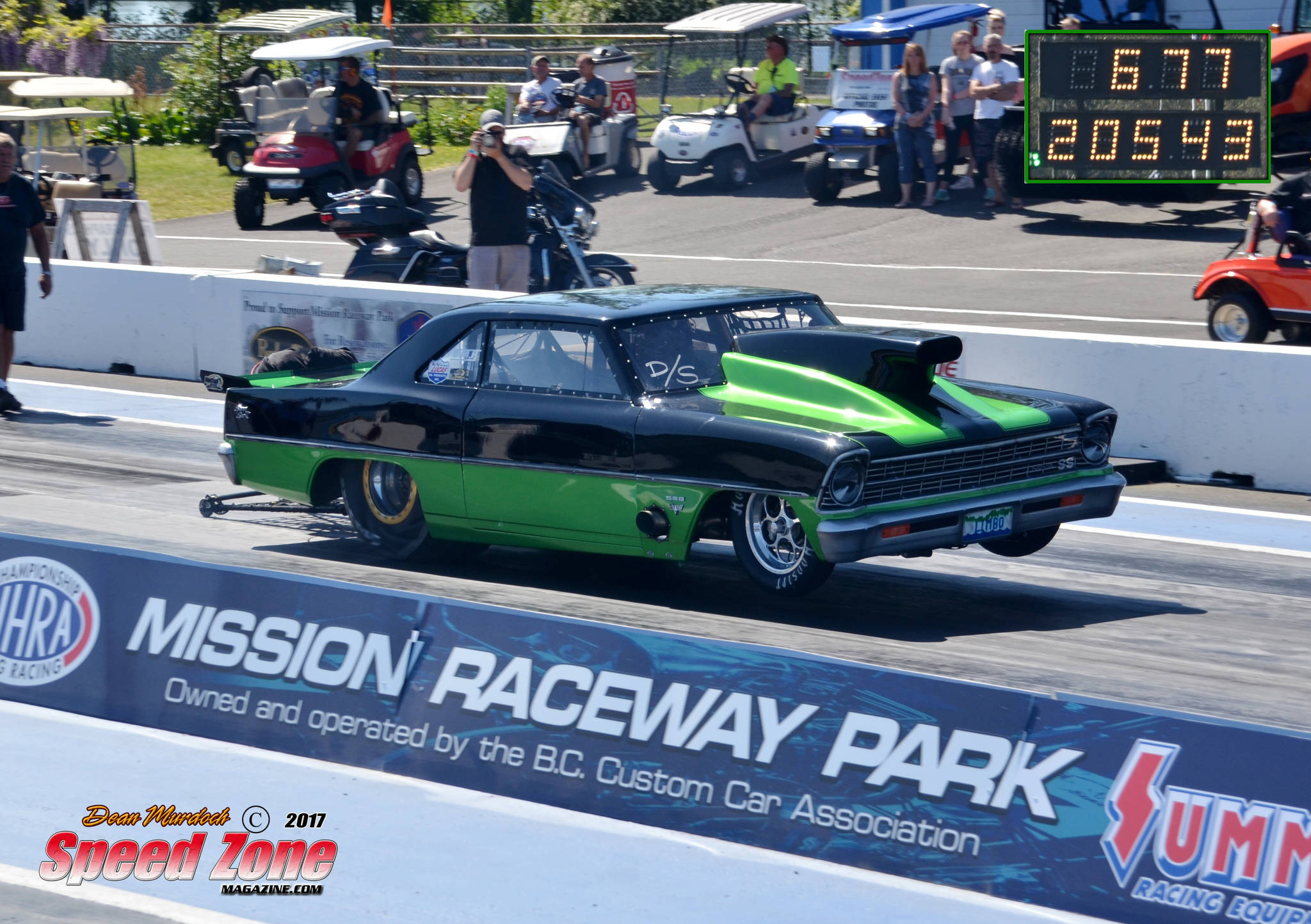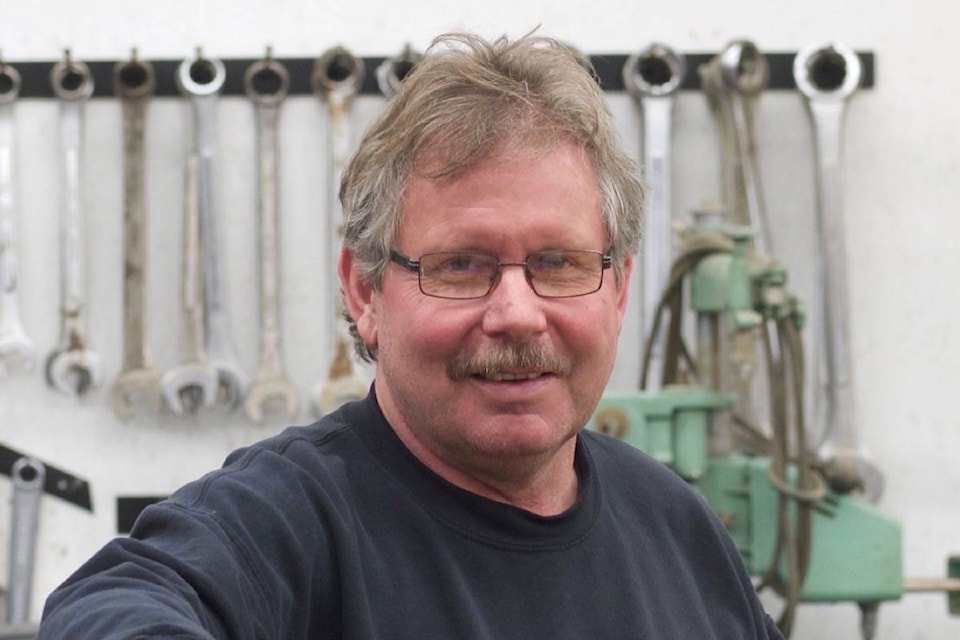Last season, he got his dragster going three times faster than most of us will ever travel on a freeway; his engine screaming at 8,000 revolutions per minute (rpm).
Now that Hope’s Rick Limb has broken his 200 miles-per-hour goal, he’s changing things up, in a quest for consistency this year. Out goes the 632 cubic inch, cast iron block and in goes a 762 cubic inch, Donovan aluminum block, shaving gobs of weight from his ride, a fibreglass body based on a ’67 Chevy Nova. The three-speed automatic transmission stays.
“I’m getting rid of the nitrous oxide as well,” said the heavy machinery contractor last Thursday.
“Nitrous is good, if you’re born and raised on it — but it’s a lot of work to tune it.”
Limb figures the lighter motor and missing nitrous system will free up 170 pounds, though he won’t know how the numbers will add up until he gets it on the track.
“The old motor was 1,250 horsepower and 950 foot pounds of torque — and an additional 700 horsepower with the nitrous added,” Limb said.
“The new one is 1,600 horsepower and 1,250 foot pounds of torque.”
Buy a brand new Dodge Charger with a 6.2-litre (380 cu. in.) Hemi V8 and you’ll get 707 horsepower and 650-foot pounds of torque.
While a gently-driven Charger might get 80,000 km on a set of tires, Limb can burn through a set of slicks in about a month of weekend driving.
“I get about 40 passes out of a tire,” he said, grinning. “Ten miles.”
At under seven seconds per pass, that’s less than five minutes, total, before a slick is toast. This is not counting the pre-race burnouts to heat up the tires, to make them bite at the starting line.
Limb started drag racing in 2010, after being introduced to the sport by a friend, Dwayne Grosart from Greendale, who raced in the Pro Mod class, running in the low 6s.
Limb bought the body and frame as a unit and added the other components. The body is mounted on a chrome-moly tube-frame chassis with four-wheel slotted disk brakes. The brakes can do the job if they have to, said Limb — but parachutes take a big load off the brake pads.
“Once you can hit 200 miles an hour, you have to have two chutes,” explained Limb.
“They’re powered by pressurized gas and I have a button on my steering wheel for the release. Once I cross the line, I kill the motor and pop the chutes. It’s always a reassuring feeling when they deploy.”
Repacking the chutes after each run is only a small part of the maintenance required.
A commuter might go through three or four oil changes in a year. Limb and his crew change the oil every weekend — and pull the filter apart after every run, to look for metal particles and other problems.
“I’ve never seen it correct itself,” Limb said. “If there are problems, it’s best to shut ‘er down.”
Limb said the motor would have to go in for work a few times a year in the past.
“Norm Wilson, at Fortin’s engine shop looks after it. Hopefully, he’ll never have to see this one, during the race season. I placed third overall in 2015 but 2016 was a washout, after taking out an engine on the first race of the season.”
Crew chief, Rennie Stieger lives in Aldergrove and assists Limb with the wrenching and grunt work in the pits. Chad Henderson, from Kamloops, does the computer work — and Limb’s wife Linda comes along to most races, to keep the crew tuned-up.
The 32-car Canada West Doorslammers club are allowed nitrous and blowers or prochargers, if they don’t mind the extra tuning required — but Limb is hoping his dual four-barrel carb set-up will make things easier for the team to get consistent times.
Henderson takes the on-board computer data after each run and makes tuning decisions, with consideration for changing weather and track conditions.
Because of the variety of motors and optional accessories, the only fair way to race is to give the slower car a head start. That’s the beauty of bracket racing: race to the absolute potential of your car on any given day and you can cross the line before a faster car.
In bracket racing, explained Limb, you get three or four qualifying runs before the eliminations begin on Sunday. During the qualifying, no one wins or loses. You get to see how your car is running and figure what its potential is going to be.
Once eliminations begin, “you post a (quarter mile) time on your windshield and that’s the time you can’t go faster than, or you ‘break out,’ which is a loss,” Limb said.
In the eliminations, a car that is running, say, .25 seconds faster than its competitor’s will be delayed by .25 seconds at the starting line. Two perfectly-run rides would have both cars crossing the line at the same time. The other 99.99 per cent of the time, the win goes to the team that gets closest to perfection.
“If you do break out of your time — or red light at the start, you hope the other driver does it worse,” Limb said. “Lose… and you go to the trailer.”
Speaking of trailers, here’s a link to a video of a few of Rick’s races, from his second season: https://www.youtube.com/watch?v=aKcACHfityg
The Limbo racing team starts its season on May 12-13 at Mission Raceways. Results and schedules can be found at CanadaWestDoorslammers.com.

